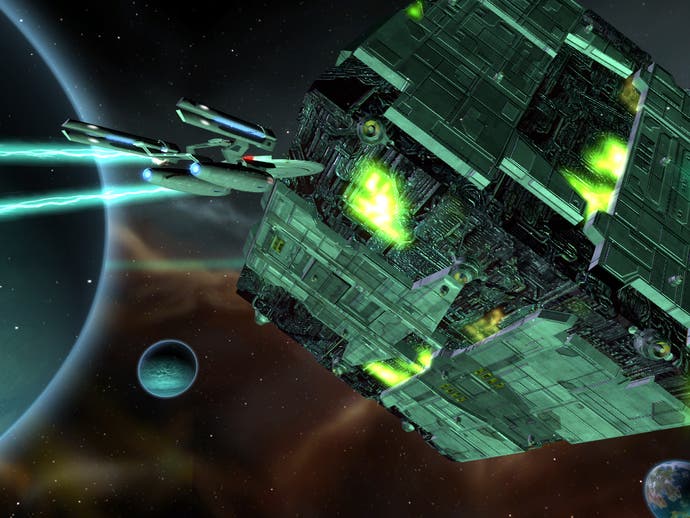Star Trek Legacy
Captain slog.
You've got to feel sorry for Star Trek fetishists - and not just in the "never going to have sex with [nice looking] girls" sense. Not only do they still represent the enduring face of unnerving geek fanaticism for the vast majority of the population, despite having kept a low profile for several decades, but their beloved franchise is in a truly woeful state. The recent movies and TV series have flopped like Shatner's six-pack, and all attempts to revive the series now hinge on Mission: Impossible III director J.J. Abrams and his Starfleet Academy movie, starring a young Kirk and Spock.
Yes, even Star Wars fans can afford to look up from their boxes of worthless prequel trinkets to snigger at the perennially unfashionable Trekkies.
Recently, however, there has been a flickering beacon of hope for the beleaguered Trek fanbase. Star Trek Legacy was to be a game that brought the shiny shiny magic of next generation gaming to the bridge of the Enterprise, tying together all five TV shows (plus the early movies) into one centuries-spanning epic story.
After all, no matter how dull the shows became, Star Trek has always maintained its own sense of identity - a utopian vision of the future where mankind is united and noble, where exploration and diplomacy drive our ambitions, and where shoot-outs and explosions are a last resort. Even I, a casual appreciator of Trek, was intrigued at the possibilities of a galaxy-spanning game in which intellect and empathy were as vital to success as phasers and photon torpedoes.
Star Trek Legacy, therefore, should have been something quite special.
Wailing frequencies open
Unsurprisingly, given the way the franchise has been fumbled in recent years, it's nothing of the sort.

The game starts off on the wrong foot right from the first level, simply because it follows the Star Trek timeline chronologically. This means the first five missions take place in the pre-Kirk era, with Scott Bakula's impossibly dull Captain Archer and the bland early years of Starfleet. Although the orchestral soundtrack is appropriately grandiose, Bakula's droning and stilted voiceover is in danger of killing the atmosphere stone dead before you've even got started.
Sadly, the disappointments don't end there. Starting out with just the Enterprise at your command, you're walked through some early challenges, learning the ropes of galactic navigation and combat along the way. You soon pick up additional craft for your small fleet, and can purchase additional "wessels" by trading in any Command Points earned during your missions.
Star Trek, of course, doesn't have many small fighter craft so the emphasis is firmly on giant cruisers, destroyers and battleships. As you'd expect, these are not the most speedy or nimble modes of transport, and movement is therefore sluggish, with wide turning circles and lumbering acceleration. This wouldn't be a problem - and would, in fact, be a rather interesting challenge - if the game itself made allowances for this different style of engagement. As it is, combat takes the form of long, drawn-out dogfights between enormous spacecraft that are woefully ill-equipped for such manoeuvres.
The sight of the Enterprise, slowly twizzling around on its arse as it tries to keep a Romulan enemy in sight, isn't really in keeping with what we see of Starfleet warfare on the TV. It looks ridiculous - and is teeth-grindingly irritating to boot.
The fanbase cannae tek it!
The control system seems equally torn between arcade-style joystick wrangling and a more strategic simulator set-up. Left stick moves your ship, right stick controls the camera and targeting reticule. Point it at something, and press A, and you fire up the impulse engines and start heading in that direction. Press A over an enemy and you lock the camera on them. Move the right stick, and the lock is lost. Pressing B brings the engines to a stop, while holding down B and using the d-pad allows you to choose full, half or quarter power. Pressing Y bumps you up to warp speed, but must be charged and cannot be used when near planets. So, already, simply moving around involves the majority of the face buttons, both joysticks and the d-pad. If the game had the depth of a simulator, this wouldn't be so bad, but as it's really a glorified shoot-'em-up, this complexity just gets in the way.
Combat isn't much better. Target lock requires you to be in range, and facing the right way. A white reticule shows your phaser lock, while a red triangular one denotes photon torpedo lock. Clicking the left stick switches on sub-system targeting, which allows you to focus your attacks on a specific facet of the enemy craft (say, weapons or engines) by holding down the A button and selecting the relevant system with the stick from a circular menu.

Once again, it's all just convoluted enough to irritate - and, with enemy fire pounding your ship, it all takes far too long to get the hang of. You'll spend the majority of your early sorties trying to translate the minimal tutorial information into some kind of practical application, at the expense of becoming engaged in the story. It doesn't help that the camera is skittish, and your target lock often blinks on and off while you wrestle with the controls to keep the enemy in the right position relative to your ship. Even once you have mastered things, the battles are revealed as pitifully shallow. Each encounter simply becomes a question of circling round and round, wearing down enemy shields with your phasers, then destroying their hull with your (limited) torpedoes or continuing with the long slow phaser attacks until they explode. Rinse. Repeat. Warp to next objective.


